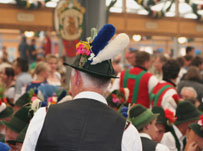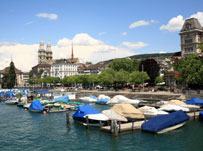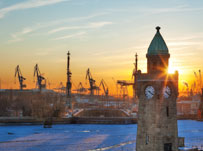Top 10 things to see and do in Milan
Milan has plenty to offer in terms of sights and attractions, but here are our top ten recommendations on what to see and do when you visit.
1. Scale Milan’s iconic Duomo
Located right in the very centre of Milan is its famous Duomo (cathedral), reputed to be one of the largest churches in the world. An amazing 3,500 statues and 135 spires adorn the gigantic marble structure that was 500 years in the making. A look around the interior of the cathedral is well worth your while, although an even more impressive sight is that which you can get from the roof! Fortunately, there is a lift in operation to take you up – you don’t have to brave the stairs – and when you reach it you’ll be able to see not only the cityscape of Milan, but also the beautiful Italian Alps in the distance.
2. Get a look at The Last Supper
Leonardo de Vinci’s The Last Supper has long been of the most famous paintings in the world, but following its inclusion in Dan Brown’s best-seller, ‘The Da Vinci Code’ it attracts more interest than ever before. The painting is housed in Milan’s church of Santa Maria della Grazie, and is by far one of the city’s most popular tourist attractions. At busy times you will need to buy a ticket in advance – you will be assigned a 15 minute slot in which to view the masterpiece.
3. Experience one of Italy’s true passions at the San Siro stadium
Food? Fashion? Football…Italians simply love their football. The San Siro Stadium is home to two of Italy’s most successful, well-loved, and, as it happens, competitive clubs! AC and Inter Milan are local rivals, yet they share the iconic 85,000 seater stadium. Even if you can’t make it to an actual match, a visit to the stadium will still give you access to tour and to the on-site museum. Quite simply a must for any football fan.
4. Indulge yourself with some window shopping in the Quadrilatero d’Oro (Golden Rectangle)
Milan is known as Italy’s fashion capital, and as such has some great shopping options. Unfortunately, many of them require a reinforced wallet and some very sparkly plastic, and are quite simply out of bounds to the average tourist. But, it can’t hurt to look! Pressing your nose against the shop windows will probably not endear you to the shop assistants, but it will give you a glimpse of some real-life Prada, Armani, Versace, Dolce & Gabbana, and Valentino…and of the rich and famous who totter in and out.
5. Visit one of the world’s oldest and most elegant shopping precincts
Continuing along the shopping theme, you may want to pay a visit to the central Galleria Vittorio Emanuele II. Again, it’s definitely geared towards a certain type of shopper, but even if you can’t afford to buy anything, it’s well worth a look. Opened in 1867, its designer Giuseppe Mengoni pioneered its complex composition of iron and glass 20 years before the Eiffel Tower was built. The ceiling vaults are decorated with mosaics representing Asia, Africa, Europe and America and at ground level there are mosaics representing the areas local to Milan too. Prada’s flagship store has been here since 1913, and is now also joined by Gucci and Louis Vuitton.
6. Enjoy some authentic ‘aperativi’ at one of Milan’s bars and cafes
Anyone new to Italy, or to Italian culture, may not be familiar with the concept of ‘aperativi’. Said to originate in Milan itself, ‘aperativi’ are free buffets provided for people who drink in bars or cafes during the early evening. How substantial the gastronomic offerings are really depends on the bar, but often you can eat enough to fill you up for the rest of the night! Milan has a massive array of bars and cafes that all offer this – take your pick and enjoy some tasty and authentic Italian food with a relaxing evening drink.
7. Discover Milan’s canals in bohemian Navigli
It would be misleading to imply that Milan has canals on a Venetian scale, but the vibrant Navigli district in Milan does have two –one of which was designed by Leonardo da Vinci. Located in the south of the city, the Navigli was not traditionally one of the most attractive parts of town, but in the last few years it has become one of the most popular areas. It has scores of bars, restaurants, boutiques and galleries, and is particularly fashionable amongst Milan’s ‘creative’ crowd.
8. Visit the Theatre Museum at La Scala
Milan’s impressive famous opera house, La Scala is well worth a visit in its own right, of course, but in reality opera tickets can be very expensive and difficult to come by. A good alternative therefore is to head to the La Scala Museum, which will give you access to the theatre and help you imagine the atmosphere at one of the world-class performances. In addition, you’ll get to learn about the history of the opera house through an extensive collection of musical instruments, portraits, busts and documents dedicated to some of the world’s greatest musicians.
9. Visit the Pinnacoteca di Brera art museum
The collection at this Milan art museum covers works by some of Italy’s most famous and influential artists from the 13th to the 20th centuries. Highlights include Caravaggio’s Supper at Emmaus and Piero della Francesca’s Virgin and Child with Saints . There’s also a studio of plaster casts and drawings, and contemporary works to explore.
10. Take a look around Milan’s acclaimed aquarium
Milan’s aquarium is one of the oldest and the largest in the whole of Italy. 36 enormous pools are filled with more than 100 different species of fish, living in recreated environments ranging from the Amazon to the Mediterranean. There’s also a terrarium with amphibians. The aquarium’s library is one of the most important resources for marine biology and oceanic studies in Italy and is also accessible to the public. A really good option for a rainy day, or a family day out.
Cactus offers General, Individual, Combined, Intensive and Business Italian courses in Milan at a variety of levels. Also available are language and fashion design courses, and language and work experience programmes.



